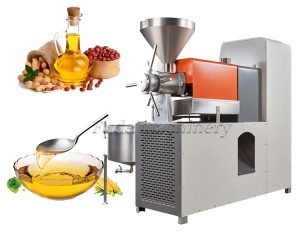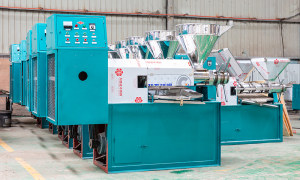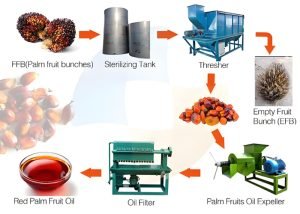Which Peanut Oil Production Process Is Right For You?
You have decided to start a peanut oil business. That is a great choice. Now you face the most important technical decision: which peanut oil press process should you use? The two main options are hot pressing and cold pressing. Your choice will directly affect your oil yield, your product’s quality, and your overall profitability.
We are Fude Machinery, a B2B manufacturer of oil processing equipment. We have helped countless entrepreneurs choose the right process. This guide will help you understand the difference and decide which process is right for your business.
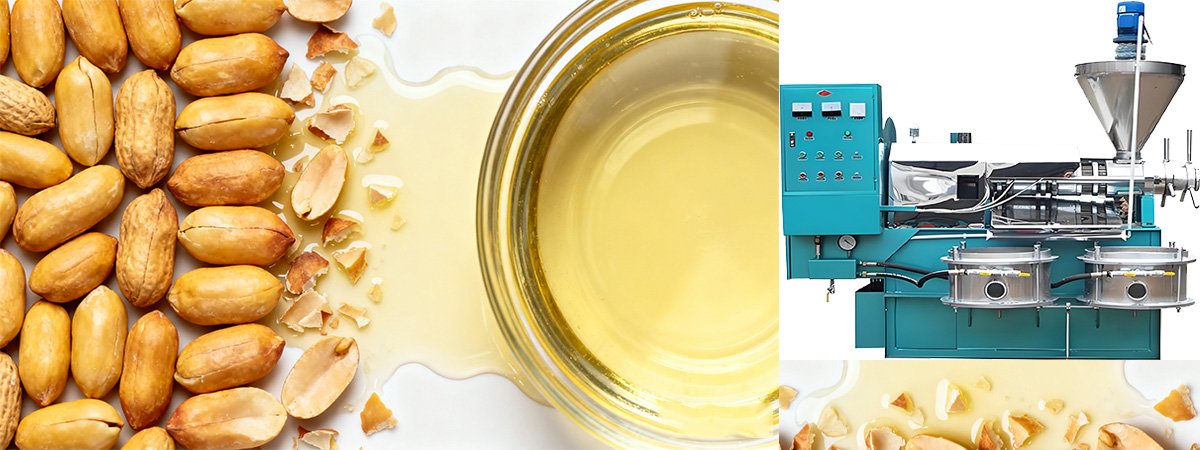
Types of oil presses?
The screw oil press is a fully automatic hydraulic-driven edible oil processing machine that employs a rotating screw shaft to advance the feedstock, enabling continuous and highly efficient oil extraction. The process involves both hot pressing and cold pressing methods.
What is the Hot Pressing Process?
The hot pressing process involves heating the peanuts before you press them. This is the most common and commercially popular method for producing peanut oil. It is designed to get the maximum amount of oil out of every single peanut.
The process is simple. First, the peanuts are cleaned and shelled. Then, they are put into a roasting machine (炒货机). This machine heats the peanuts to a temperature of around 120°C to 130°C. This pre-heating step is very important. The heat breaks down the internal cell structure of the peanuts and makes the oil much less viscous, or thick. This allows the oil to flow out very easily when it is inside the peanut oil press. The result is a high oil yield and a rich, aromatic oil with a characteristic roasted peanut flavor.
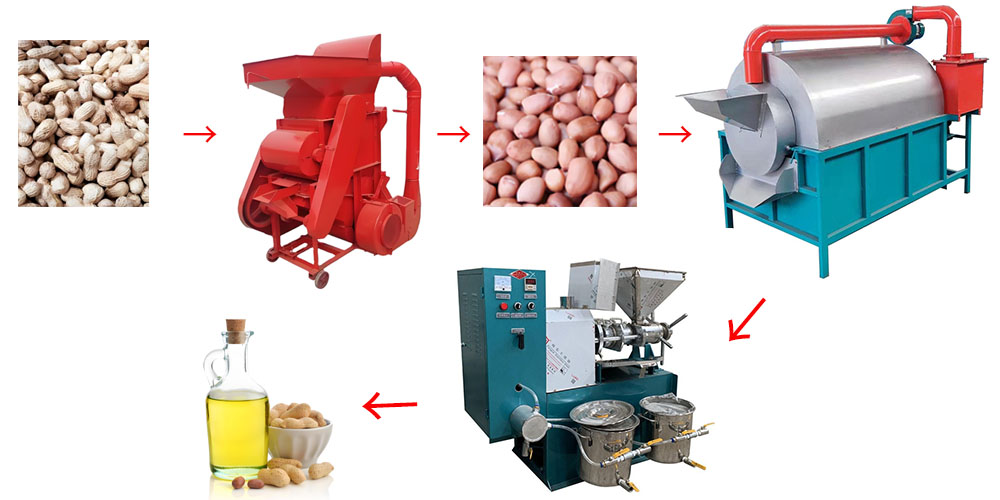
What is the Cold Pressing Process?
The cold pressing process extracts oil from peanuts at room temperature. No pre-heating is involved. This method is focused on preserving the natural quality and flavor of the oil.
In this process, the peanuts are shelled and cleaned, but they are not roasted. They are fed directly into the peanut oil press at their natural temperature. Because the peanuts are not heated, the oil is thicker and harder to extract. The machine needs to work harder to squeeze the oil out. This results in a lower oil yield compared to hot pressing. However, the oil produced is of very high quality. It is often lighter in color and has a mild, fresh peanut flavor. This type of oil is often marketed as a premium, “virgin,” or “raw” product.
How Do You Choose the Right Process?
The right peanut oil press process for you depends on your business goals. Are you focused on producing a large volume of oil for the mass market? Or are you targeting a niche market for high-end, artisanal products? Answering this question will make your choice clear.
For Maximum Profit and Volume: Choose Hot Pressing
If your business goal is to produce the most oil possible and maximize your daily profit, hot pressing is the clear choice. The higher oil yield means you have more product to sell from the same amount of raw material. The strong, roasted aroma is also what most consumers expect from standard cooking peanut oil. This makes it easier to sell in the general market.
For Premium Quality and High-End Markets: Choose Cold Pressing
If you plan to sell your oil in health food stores, to gourmet restaurants, or directly to consumers who want a premium product, cold pressing is the way to go. You will produce less oil, but you can sell each bottle for a much higher price. The “cold-pressed” label is a powerful marketing tool that signals high quality and natural purity to customers.
| Feature | Hot Press Process | Cold Press Process | What This Means for Your Business |
|---|---|---|---|
| Oil Yield | High (40-45%) | Lower (30-35%) | Hot pressing gives you more product to sell from the same tonnage. |
| Oil Quality | Good, strong roasted flavor. | Excellent, mild natural flavor. | Cold-pressed oil can be sold at a higher price per liter. |
| Equipment | Press + Roasting Machine | Press Only | Hot pressing requires a small additional investment in a roaster. |
| Target Market | General cooking oil market. | Premium, health, and gourmet markets. | Your choice depends entirely on who your customers are. |
Key steps in the oil extraction process
Yes, the pressing itself is just one part of a complete production line. To create a professional, market-ready product, you need to include pre-treatment and post-treatment steps. These steps are essential for both the hot press and cold press methods.
Step 1: Peanut Shelling (The Non-Negotiable Start)
You must remove the peanut shells before you do anything else. Pressing peanuts with shells on is a big mistake. The shells absorb a lot of valuable oil, which gets wasted. They also cause rapid wear and tear on the expensive internal parts of your peanut oil press. A simple peanut shelling machine is a low-cost investment that protects your main machine and increases your oil yield.
Step 2: Oil Filtering (Creating a Clean Product)
The oil that comes directly from the press is called crude oil. It is full of tiny solid particles that make it look cloudy. You must filter this oil. An oil filter press is a machine that pushes the oil through special cloths to trap all the solids. This creates a clean, bright, and stable oil that is ready for bottling and selling. This step is essential for customer satisfaction.
For more information on the characteristics of your raw materials, you can read about what are the key characteristics of oily materials.
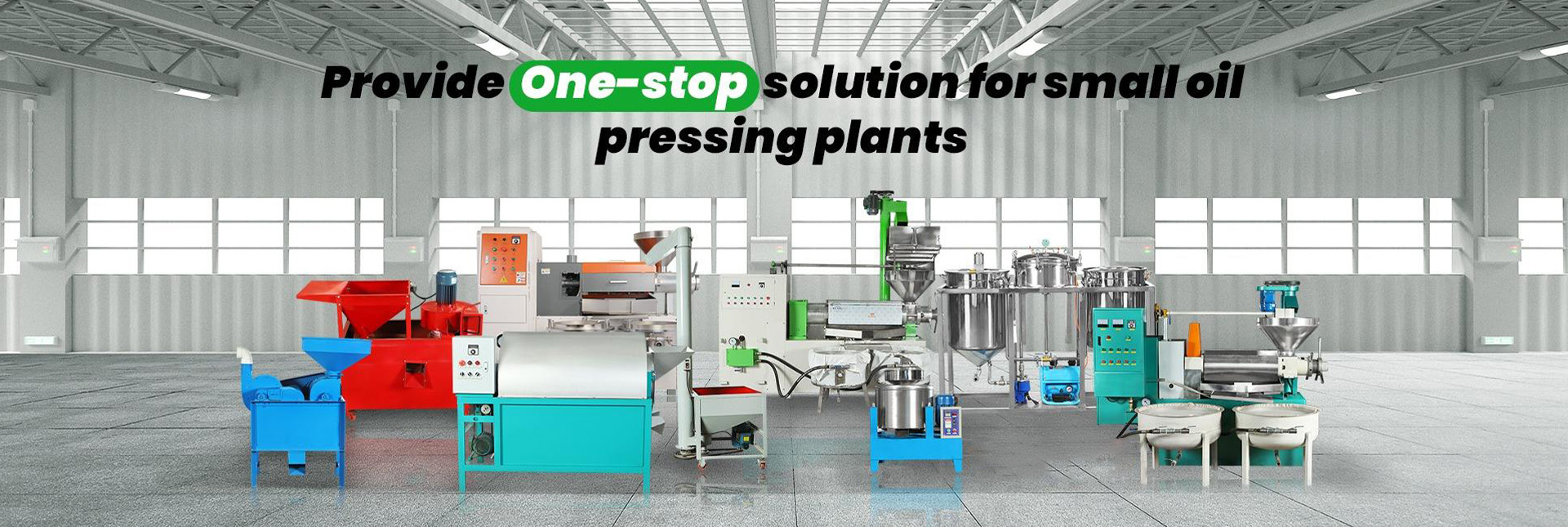
2026 Trend: Flexible Production Lines
The modern trend for 2026 is building flexible production lines. Business owners want the ability to switch between hot pressing and cold pressing based on market demand. We design our peanut oil production lines to be modular. This means you can have a roasting machine in your line, but you can also easily bypass it. On Monday, you can run a large batch of hot-pressed oil for a commercial client. On Tuesday, you can bypass the roaster and produce a small batch of premium cold-pressed oil for a local health food store. This flexibility allows you to serve multiple markets and maximize your overall business potential.
Summary and Recommendation
Choosing the right peanut oil press process is a strategic decision.
- Choose Hot Pressing if your goal is high volume, high yield, and maximum profitability for the general market.
- Choose Cold Pressing if your goal is to produce a premium, high-quality oil for a niche market and you can charge a higher price.
Regardless of your choice, remember that proper pre-treatment (shelling) and post-treatment (filtering) are essential for a successful operation. The best approach is to build a flexible line that allows you to do both.
About Fude Machinery
We are Fude Machinery, a professional B2B manufacturer of oil processing equipment based in Zhengzhou, China. As a factory-direct company, we provide our global partners with high-quality, reliable machinery at competitive prices. We specialize in designing and installing complete, turn-key oil mill plants that are tailored to your specific business goals. Our equipment is trusted by entrepreneurs in over 120 countries.
Are you ready to build your profitable peanut oil business?
Contact our expert team at Fude Machinery today. We are here to provide a professional consultation and help you design the perfect production line for your needs.
Related recommendations
-
Do you have any requirements for tea seeds for the tea seed peeling machine
310The requirements of the tea seed sheller for tea seeds mainly include maturity, dryness, cleanliness, consistency of specifications, and storage status
View details -
How to buy screw oil press
230Selecting the perfect machine is crucial for your business success. We understand the challenges involved. Let's break down everything you need to know about screw oil presses, step by step. We want to empower you to make an informed decision. ...
View details -
Introduction to multifunctional oil press
458Spiral oil press is a multifunctional equipment with the following characteristics: simple structure, small volume, easy maintenance, diverse oil pressing materials, high oil yield, large production capacity, and continuous processing.
View details -
How to Establish a CPO Refinery: A Guide suggestion
241Building a successful CPO refinery is a major project that turns low-value crude palm oil into high-value food products. It is a highly profitable venture. But success requires more than just buying machines. It demands careful planning, smart de...
View details
 Oil Press Equipment and Oil Refining Machinery for Sale – Start Your Oil Press Business
Oil Press Equipment and Oil Refining Machinery for Sale – Start Your Oil Press Business

